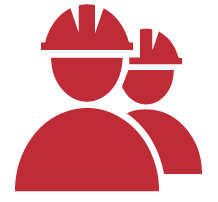With rapidly changing information related to the COVID-19 pandemic we are diligently trying to assess cost impacts for current and future estimates. There are factors that may increase cost and others that may decrease cost. While the whole picture has not come entirely into focus just yet, some patterns are beginning to emerge.
COVID-19 Cost Implications
Insight from Jared Lachapelle, Chief Estimator, Consigli
We are connecting with hundreds of subs and suppliers each week through a strong workbook of pre-construction and bidding opportunities, as well as on-going project procurement for which we are awarding 30-40 contracts per week. We expect to learn a lot in April and May and will provide updates along the way.
 EXPECTATIONS
EXPECTATIONS
Our expectation is that the next few months will be turbulent, fueled by uncertainty at all levels of our industry. We therefore expect inconsistency related to cost, with some projects experiencing cost increases while others remain somewhat steady. We expect this pattern to continue as long as many construction sites and non-essential businesses are closed.
We expect stabilization relatively soon after construction broadly resumes. We expect costs to increase related to COVID-19 protocols as further described below but anticipate some or all those costs to be offset by de-escalation related to bidder aggression. We believe it unlikely that costs will rise as much as recent years where we saw as much as 7-8% escalation in some areas, comparing future costs to pre-COVID. We therefore expect, on average, to see zero to moderate per annum increases in the near-term, depending of depth and duration of a recession.
 EVIDENCE OF PRICING STABILITY
EVIDENCE OF PRICING STABILITY
CURRENT PROCUREMENT
Procurement of subcontracts and materials purchases had revealed no trend change from recent awards through Friday April 3rd. The variance from budgets set by GMP’s remains typical. However, the COVID-19 safety protocols now being implemented industry wide and formalized into job specific plans have been deployed to subcontractors for inclusion in bids moving forward. We have some early impressions discussed below.
MATERIALS/EQUIPMENT PRICING
Supply chain issues do not appear to impact costs at this time, but this could change rapidly and meaningfully based on each manufacturer’s supply logistics, and whether or not and to what extent their workers and partners are directly affected by positive tests for COVID-19.
Subs and suppliers continue to consistently report minimal to no lead time impacts and no cost impacts. Most manufacturers/fabricators have reported operating at or near capacity and generally keeping up with demand. Subcontractors are consistently reporting that supply chains have been altered where needed mitigating any potential impacts. Cox Engineering CEO Jon Desmond reported in an industry roundtable hosted by Vermeulens, that supply chains are in-tact, with some Chinese supplies currently being procured elsewhere due to on-going trade tensions pre-dating COVID-19. Additionally, one manufacturer reported canceling a planned Spring price increase.
We anticipate a greater level of flexibility in material specification and selection, provided we do our part to source and present appropriate alternatives.
 POTENTIAL FOR VOLATILITY
POTENTIAL FOR VOLATILITY
BIDDING BEHAVIOR
In spite of general stability at this moment, things are evolving daily, and stability could begin to erode quickly, pending further economic news, COVID-19 surge and regulations. We expect at least some near-term volatility in bidding behavior as subs/suppliers scramble to determine and implement procedure and protocols, adjust to remote working conditions, react to evolving supply chain conditions, manage cash flow and book new work reacting to stoppages and economic news.
A greater level of vigilance will be required in evaluating proposals for completeness. As subs/suppliers’ anxiety rises they may feel compelled to bid more work but may not posses the resources to do so effectively, resulting in pricing that is artificially high or low. We will continue to scrutinize proposals to ensure that no undue risk is taken.
We could begin to see discounts offered, which may present risk as it could be a sign of cash flow problems. Discounts can be attractive and may well benefit the buyer, but with some potential cost increasing forces (described below), extra care must be taken to ensure viability of the offer and offeror’s financial stability.
QUALITY OF INFORMATION
We are concerned that apparent supply stability portrayed by suppliers may be overly optimistic. We do not have direct evidence of misinformation and we believe what we are being told (directly) is sincere. However, a race to book work could lead to artificially optimistic views of manufacturing capacity and lead times, requiring additional scrutiny and further verification if possible.
 SOURCES OF INCREASED COST
SOURCES OF INCREASED COST
LABOR PRODUCTIVITY HINDERED BY COVID-19 PROTOCOLS
Productivity is being impacted by working restrictions and COVID-19 protocols, though it is not yet quantifiable. Currently we are not yet seeing this translate into increased pricing for sub/supplier bids, but this may change. It is unclear to what extent productivity for individual tradespeople has been compromised in terms of output per worker-hour.
As protocols become more widely understood and implemented, we expect trade productivity loss to cause some cost increases. Some sources of productivity loss are: additional non-working time for COVID specific tool box talks and temperature testing; more frequent cleaning of elevators/hoists and similarly constrained spaces; daily cleaning of tools and equipment; staggered trade workday starts; and 6’ distancing requirements. The distance requirements will undoubtedly affect some operations more so than others. For example, many siding panels are installed with two workers closer than six feet, with alternatives in some cases not immediately obvious. For projects still in design, alternative materials and sizing may offer effective solutions. On the other hand, operations such as installing light fixtures, setting tile and painting that can be accomplished with a single worker may not be impacted. Other operations performed by crews, such as utilities, concrete forming and steel erection so far seem generally productive while maintaining proper distance.
This week, with site specific safety COVID plans in place, we’re starting to see bidders reacting with cost premiums. Albeit a small sample size, we are seeing premiums ranging from 2%-3.5%, with one outlier at 6.8%. These range across multiple trades, multiple jobs and a broad range of trade dollar values. One bidder reported a cost range resulting in 2.9-8.6%, which highlights the uncertainty and challenges with quantifying lost productivity.
In future updates we will expand on the productivity loss more precisely and report on trends with broader information.
EXTENDED SCHEDULES/GENERAL CONDITIONS
Although individual worker output is not compromised in some cases, there is an overall project-wide daily output reduction due to fewer workers on site. Many activities on site that were previously scheduled with start-to-start lags are now start-to-finish operations. This will have an impact on schedules, requiring longer days, 6- or 7-day work weeks, or longer durations, which will increase Division 01 costs for staffing and temp facilities rentals, etc.
INCREASED PROJECT REQUIREMENTS
Other Division 01 costs will increase due to sanitation, monitoring and reporting protocols, such as additional cleaning of common areas, job trailers, more frequent emptying of trash receptables, hourly cleaning of high touch surfaces, hand wash stations with warm water, sanitation/hygiene signage, additional PPE, technology to support greater remote collaboration and job office size/configuration to facilitate distancing.
 SOURCES OF DECREASED COST
SOURCES OF DECREASED COST
BIDDER AGGRESSION
Work stoppages and the prospect of further project postponements and/or cancellations represent a disruption to the cost model for many trade partners. Since the financial crisis recovery, we have seen sustained growth which came with higher margins for many subs/suppliers. We expect many of them to demonstrate aggression based on fewer opportunities, or at least a near term fear of few opportunities. One open shop electrical subcontractor conveyed that what had been 150 bid invites received per week has turned into 20 / week.
We expect this to result in greater subcontractor participation and therefore competition. If this occurs it will act as a counterbalance to the forces increasing cost, but as noted above, it is not clear what the net effect will be and will depend heavily on the duration businesses and jobs are closed and the speed of subsequent economic recovery.
CURRENT EVIDENCE OF FOCUS SHIFT
While we don’t yet have direct evidence of cost reductions relating to a strategic shift from margin to volume some subs are noticeably anxious. Some have specifically referenced holes in their schedules, and we’ve seen a broad increase in post-bid follow up from subs/suppliers.
To access a full PDF of this information, click here:
Material-Cost-Update_041420
